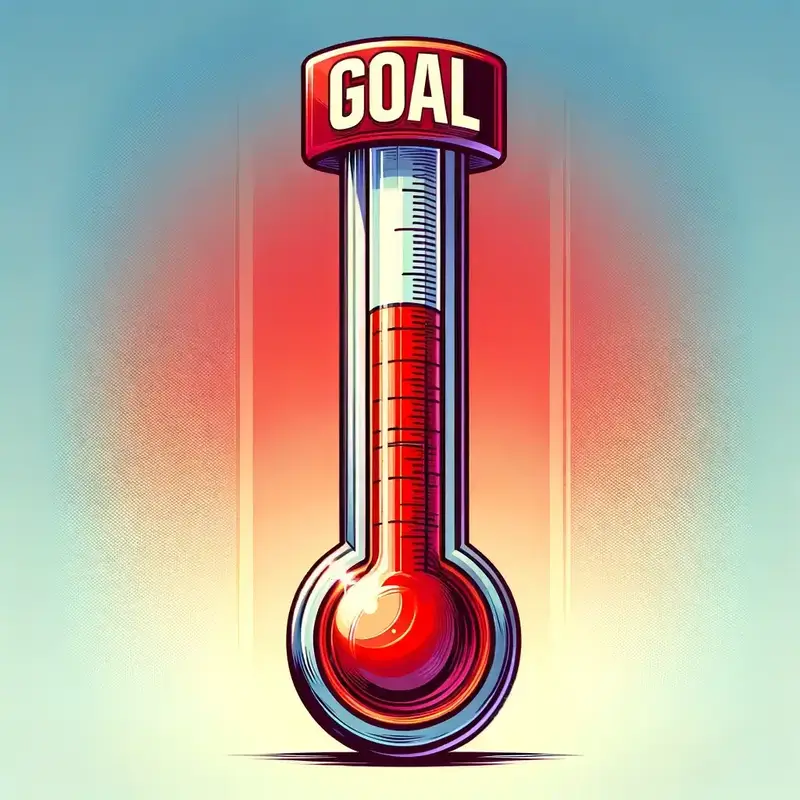Have you ever felt like you’re trying to improve your life, but your progress feels vague or hard to measure? If you crave clarity and a proven path for personal growth, it’s time to learn about quantitative goals.
Unlike goals focused solely on self-improvement, quantitative goals center around tangible, numerical targets. This clear-cut approach offers more than just focus. Quantitative objectives make it easy to track your progress, celebrate victories, and stay motivated to transform your reality, one achievable step at a time.
Let’s explore quantitative goals examples and how to incorporate them into your life.
Qualitative vs Quantitative Goals
When embarking on any personal development journey, setting clear goals is key. But there are different types of goals, each with its unique strengths.
Quantitative and qualitative goals are two powerful tools at your disposal, and understanding their distinct characteristics will help you make the most informed choices for achieving your objectives.
Their Main Difference
At their core, the difference between quantitative and qualitative goals lies in how they are measured:
- Quantitative Goals: Focus on tangible, numerical targets. Their success is determined by hitting specific, measurable outcomes. (Example: Run 2 miles in 10 minutes)
- Qualitative Goals: Center around improving qualities, characteristics, or processes. Their success rests on growth and internal development. (Example: Becoming a more effective communicator)
Pros and Cons of Each Type of Goals
| Goal Type | Pros | Cons |
|---|---|---|
| Quantitative | * Clear progress tracking | * Can be overly rigid |
| * Objective and measurable | * May focus on numbers over the process | |
| * Provides tangible motivation | ||
| Qualitative | * Focus on internal improvement & growth | * Difficult to measure in concrete terms |
| * Promotes a growth mindset * | Can feel less defined or achievable | |
| * Flexible and open to changing circumstances |
Quantitative Goal Examples for Different Aspects of Life
Quantitative goals can be tailored to virtually every aspect of life, enhancing personal growth, productivity, and overall satisfaction.
”The trouble with not having a goal is that you can spend your life running up and down the field and never score.” – Bill Copeland
Fitness
- Strength Focus: Increase your bench press one-rep max by 20 pounds within 3 months.
- Cardiovascular Improvement: Complete a 10k run in under 50 minutes by the end of the year.
- Flexibility Gain: Achieve a full side split within 6 months with consistent stretching.
- Body Composition: Reduce body fat percentage by 5% within 3 months through exercise and healthy eating.
- Endurance Challenge: Hike to the summit of a local mountain and back within one day.
- Skill Acquisition: Master 10 consecutive pull-ups without stopping.
- Balance and Stability: Hold a yoga tree pose for one minute on each side without wobbling.
- Increased Activity: Consistently walk 12,000 steps per day for a month.
- Repetition Goal: Complete 50 push-ups in a row by the end of the month.
- Sports Performance: Improve your golf swing speed by 10 mph within 2 months.

Professional Development
- Skill Acquisition: Learn two new industry-related skills within 6 months.
- Networking: Connect with 50 professionals in your field by the end of the year.
- Productivity: Complete your daily to-do list 90% of the time each month.
- Certifications: Earn a professional certification in your field within the next 12 months.
- Public Speaking: Deliver 5 public speeches or presentations within the next year.
- Leadership Role: Achieve a promotion or transition into a leadership position within 18 months.
- Professional Reading: Read 20 books related to your profession by the end of the year.
- Work-Life Balance: Limit work-related emails and calls to weekdays before 8 PM.
- Mentorship: Become a mentor to at least one junior colleague or peer in the next 6 months.
- Conference Participation: Attend 3 industry-specific conferences within the next year to enhance knowledge and network.
Educational
- Reading: Read 24 books in a year, across various genres.
- Languages: Achieve conversational fluency in a new language in 18 months.
- Courses: Complete 10 online courses related to your interests or career in a year.
- Lectures: Attend at least 20 educational seminars or webinars within the year.
- Writing: Write and publish 5 articles or papers in your field of interest within the next year.
- Research: Conduct a comprehensive research project over the next 12 months and publish the findings.
- Study Hours: Dedicate 100 hours to studying a new subject or skill outside of your current expertise within 6 months.
- Academic Performance: Achieve a GPA of 3.5 or higher in your next semester.
- Educational Workshop: Lead a workshop or seminar on a topic you’re knowledgeable about by the year’s end.
- Examination Scores: Prepare for and score above 85% on a professional or academic examination within the next year.
Personal Development
- Daily Learning: Dedicate 30 minutes each day to learning something new outside your professional field.
- Personal Projects: Complete 3 personal projects or goals within the next 6 months.
- Time Management: Reduce screen time to less than 2 hours per day.
- Self-Care: Implement a weekly self-care routine that includes at least 3 different activities.
- Mindfulness Practice: Accumulate 100 hours of mindfulness practice or meditation by year-end.
- Positive Affirmations: Recite positive affirmations to yourself for 5 minutes every morning.
- Problem-Solving: Solve 50 puzzles (like Sudoku or crosswords) within the next 3 months to enhance problem-solving skills.
- Creativity Boost: Engage in a creative activity, such as painting or writing, once a week.
- Digital Detox: Spend one weekend per month completely offline.
- Gratitude Journaling: Write down 5 unique things you are grateful for every day for a year.
Social & Relationships
- Family Activities: Plan and execute one family outing or activity every month.
- New Friends: Make 5 new friends within the next year who share similar interests or goals.
- Relationship Check-ins: Conduct a monthly “relationship check-in” with your partner or close friend.
- Community Service: Join a community service or social club and attend meetings or activities twice a month.
- Support System: Create a support group with at least 3 members for sharing goals and achievements.
- Active Listening: Practice active listening in all conversations for a month, focusing on fully understanding the speaker without interrupting.
- Social Skills: Enroll in a social skills workshop or course within the next 6 months.
- Friendship Maintenance: Reach out to a long-lost friend or acquaintance every week.
- Collaborative Projects: Start a project that requires collaboration with friends or family, aiming to complete it in 6 months.
- Cultural Exchange: Participate in a cultural exchange program or event in your community within the next year.
Environmental
- Tree Planting: Plant 100 trees within the next year.
- Plastic-Free: Live completely plastic-free for one month.
- Carbon Footprint: Calculate your carbon footprint and reduce it by 20% within 12 months.
- Sustainable Eating: Adopt a vegetarian or plant-based diet two days a week.
- Water Conservation: Reduce your household water usage by 15% over the next 6 months.
- Eco-Friendly Products: Switch to using only eco-friendly and biodegradable products in your home within the next 3 months.
- Zero-Waste Lifestyle: Implement a zero-waste lifestyle, reducing your trash to less than one jar per month.
- Public Transportation: Use public transportation or carpool for all your commuting needs for at least 3 months.
- Energy Audit: Conduct a home energy audit and implement recommendations within the next 3 months.
- Local Sourcing: Commit to buying only locally sourced groceries and products for 6 months to reduce carbon emissions from transportation.
How to Set your Own Quantitative Goals in 5 Steps
Want to take control of your personal development and set clear goals that you can confidently pursue? This is where quantitative goals come into play!

With their focus on numbers and measurability, quantitative goals give you focus and the tools to track your progress.
#1 Reflect on Your Values and Priorities
Goal setting shouldn’t be just about random tasks or arbitrary numbers. Truly effective quantitative goals are rooted in something deeper – your core values and priorities. Take some time to think about these foundational questions:
- What truly matters to you in life? Consider your passions, your beliefs, and what you hold most important.
- What areas do you want to change or improve upon? Be honest with yourself. Are there areas where you feel stuck or dissatisfied?
- What kind of life do you envision for yourself? Let your future goals guide the priorities you set today.
“A goal properly set is halfway reached.” – Zig Ziglar
Understanding your values and priorities ensures that your goals are meaningful and aligned with what you truly want in life. This alignment increases motivation and the chance of long-term success.
#2 Identify Key Areas for Development
Once you’ve reflected on your values and priorities, it’s time to zero in on the specific areas you want to change or improve. Your reflection in Step 1 should give you some clues, but here are some common categories to consider:
- Fitness: This could include goals around weight management, physical strength, endurance, or flexibility.
- Professional Development: Career advancement, skills acquisition, certifications, networking.
- Education: Academic performance, new skills outside your main expertise, completing specific courses.
- Personal Growth: Habits, mindset, time management, creativity, mindfulness.
- Relationships: Family connections, friendships, romantic partnerships, improving social skills.
- Environmental Responsibility: Reducing your carbon footprint, living more sustainably.
Clearly defined areas of focus will shape your specific goals and give you a tangible direction to track progress. You don’t have to improve everything at once – pick a few key areas that excite you and align with your priorities.
#3 Make Your Goals SMART
The SMART framework is a popular and powerful tool to transform your aspirations into focused, achievable quantitative goals. It stands for:
- Specific: Your goal should be as clear and unambiguous as possible. Avoid vague statements and focus on exactly what you want to achieve.
- Measurable: Attach a numerical target to your goal, so you can track your progress and know definitively when it’s reached.
- Achievable: Goals should be ambitious enough to be motivating but stay rooted in reality. You want to challenge yourself without setting yourself up for disappointment.
- Relevant: Make sure your goal aligns with your priorities from Step 1 and has a meaningful connection to your broader life path.
- Time-bound: Assign a specific deadline to your goal to create a sense of urgency and focus your efforts.
Using the SMART framework gives your goals clear structure, making them more real and tangible. This framework motivates you and gives a clearer map for success.
#4 Break Down Your Goals
Large, intimidating goals can easily lead to procrastination or overwhelm. The trick is to break them down into smaller, more manageable steps. Let’s take an example:
- Overarching Quantitative Goal: Run a marathon in under 4 hours by the end of the year.
Here’s a sample breakdown, working backward from the end goal:
- Month 11: Complete a half-marathon race without stopping.
- Month 9: Increase weekly long runs to 15 miles comfortably.
- Month 6: Regularly maintain a 9-minute-per-mile pace during training runs.
- Month 3: Run at least 10 miles without stopping.
- Month 1: Establish a consistent running routine 4-5 days per week.
Breaking down goals makes them seem less daunting and provides you with clear milestones to work towards. Celebrating these smaller victories provides ongoing motivation and makes the big goal seem more attainable.
#5 Track, Review, and Adjust
The best goals are dynamic, not set in stone! Regular tracking and review are essential to adapting your goals and strategies for lasting success. Here’s how:
- Track Your Progress: Choose a tool that works for you – it could be a dedicated app, a spreadsheet, a fitness tracker, or even a simple handwritten journal. Consistently record your progress towards your goals. Visualizing the data is immensely motivating!
- Schedule Regular Reviews: Set aside time weekly or monthly to review your progress. Ask yourself:
- What’s working well?
- What challenges have you encountered?
- Do your goals or strategies need adjusting based on your results?
- Embrace Flexibility: Things change, and that’s okay! Sometimes unexpected life events or changes in your priorities demand a shift in your goals. Don’t get discouraged – adapt and continue on a new path toward success.
Tracking and review highlight successes and areas for improvement. Regularly evaluating allows you to pivot and ensure you’re always putting your best efforts forward. This flexibility ultimately boosts your chances of achieving your goals!
Conclusion
As you embark on your personal development journey, the power of quantitative objectives is undeniable. They provide a roadmap, boost motivation, and allow you to celebrate your progress with tangible results.
While qualitative goals are crucial for internal growth, the measurability offered by quantitative targets gives you an unparalleled sense of focus and accomplishment.
Your Next Steps
Armed with these insights and examples, here’s how to harness quantitative goals for your own success:
- Reflect: Dedicate time to identifying your top priorities and values. What areas of your life are you truly passionate about transforming?
- Get SMART: Choose a few quantitative goals relevant to your priorities and make them Specific, Measurable, Achievable, Relevant, and Time-bound.
- Start Small, Stay Consistent: Break large goals into smaller steps. Consistent action, even when it’s a tiny step, yields greater results than sporadic bursts of effort.
- Track and Celebrate: Keep a record of your progress, whether in a journal or app. Recognizing each milestone along the way will fuel your motivation to continue.
- Adjust and Adapt: Remember, flexibility is key! Evaluate your goals periodically, modify them as needed, and never hesitate to explore new quantitative challenges.
Individuals with specific goals have a 90% greater chance of success on tasks than those with vague or no goals. - Edwin A. Locke
The journey of personal development is never-ending. Let quantitative goals be your constant guideposts as you build the life you truly desire!
Quiz Time!
Frequently Asked Questions
I’m new to goal setting. Where do I even begin?
Start small! Don’t feel pressured to overhaul every aspect of your life at once. Choose one area you’re genuinely excited to improve.
Maybe it’s completing a short fitness challenge or saving a specific amount of money. Starting with attainable goals builds confidence and motivation for bigger ones in the future.
Can I combine quantitative and qualitative goals?
Absolutely! In fact, a balanced approach often leads to the greatest success.
For example, a quantitative goal might be “Run a 5k race in 30 minutes” while a related qualitative goal could be “Develop a love of running.” Achieving the number is motivating, but also focusing on the underlying process cultivates long-term passion.
What if I fail to reach my quantitative goal?
Failure is a natural part of the learning process. Instead of letting it discourage you, analyze what happened. Did you set an unrealistic target? Were there unexpected obstacles?
Use this data to adjust your goals or your approach going forward. Be persistent, adapt, and celebrate your progress regardless of whether you hit the specific number initially planned.
How do I stay motivated while pursuing quantitative goals?
Here are some tips:
- Visualize your success: Imagine how achieving your goal will feel.
- Track your progress: Seeing your numbers move toward the target is a potent motivator.
- Reward your milestones: Celebrate even small victories along the way.
- Share Your Goals: Telling supportive friends or family can make you more accountable.
Are there any resources to help me with setting and tracking quantitative goals?
Yes, many! Here are a few ideas:
- Goal-Setting Apps: Check out apps like Habitica, Strides, or GoalsOnTrack.
- Journaling Templates: Search online for goal-planning templates for your journal.
- Inspiring Websites or Blogs: Many blogs (like Elevation Vibe!) offer free advice and encouragement on goal setting.




